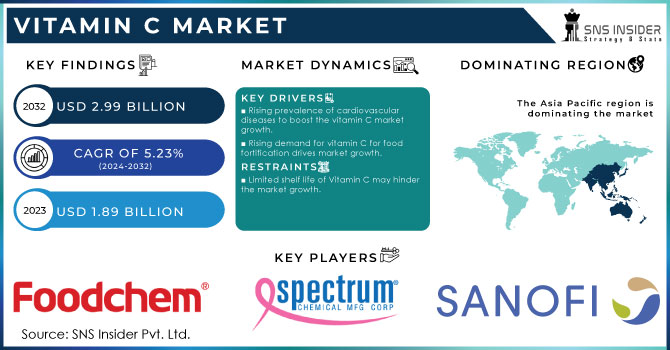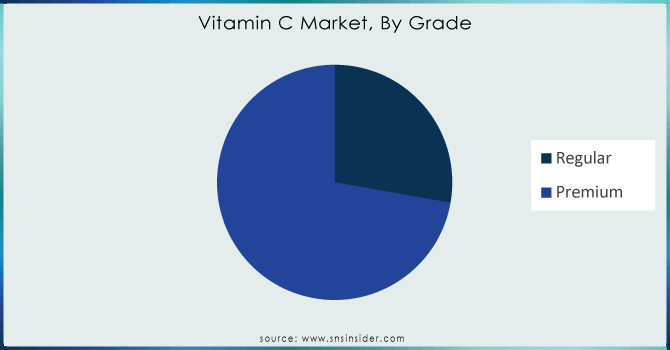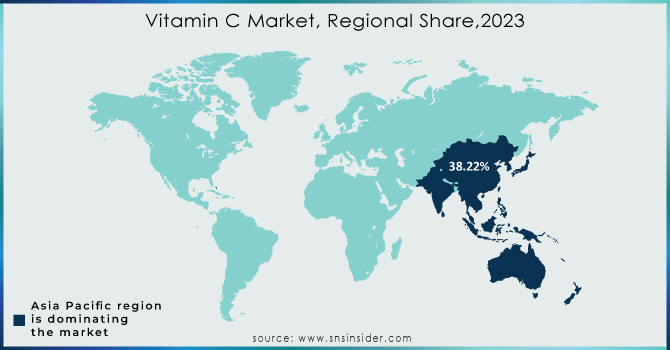Vitamin C Market Report Scope & Overview:

Get More Information on Vitamin C Market - Request Sample Report
The Vitamin C Market Size was valued at USD 1.89 billion in 2023 and is expected to reach USD 2.99 billion by 2032 and grow at a CAGR of 5.23% over the forecast period 2024-2032.
One major factor is the increasing awareness of the importance of vitamin C for immune function and overall health. Consumers are actively seeking ways to improve their well-being, and vitamin C supplements are seen as a convenient and effective option. Research suggests that vitamin C may help reduce inflammation and oxidative stress, both of which are linked to the development of chronic conditions that drive the vitamin C demand in the market.
Furthermore, the booming cosmetics industry, particularly in North America, is utilizing vitamin c's antioxidant properties in skincare products. Vitamin C can help protect the skin from sun damage and promote collagen production, which leads to a more youthful appearance. This trend is expected to continue as consumers become increasingly interested in natural and effective anti-aging solutions.
As per the National Institutes of Health in 2023, the recommended dietary allowance for vitamin C is 90 mg/day for adult men and 75 mg/day for adult women. According to the USDA's 2022 dietary guidelines, major sources of vitamin C in the American diet include citrus fruits, strawberries, kiwi, bell peppers, broccoli, Brussels sprouts, and tomatoes.
The National Health and Nutrition Examination Survey data from 2021 indicates that less than 7% of the U.S. population has serum vitamin C concentrations indicative of deficiency. The NHANES 2021 report shows that approximately 29% of adults in the U.S. take a vitamin C supplement. Therefore, these all factors show the growing demand for the vitamin C market.
The vitamin C market has growth of e-commerce platforms and online retail. Nowadays, consumers can easily find a large selection of vitamin goods, many of which come with thorough product descriptions, user ratings, and tailored suggestions. Since people can now choose and buy products that suit their unique requirements and preferences from the comfort of their homes, the convenience and variety provided by online merchants have led to a rise in demand for vitamins.
Market Dynamics
Drivers
Rising prevalence of cardiovascular diseases to boost the vitamin C market growth.
The escalating prevalence of cardiovascular diseases is a powerful driver behind the surging vitamin C market. This connection is fueled by the potential benefits vitamin C offers for heart health. Vitamin C's antioxidant properties act as a shield, neutralizing free radicals that damage cells and contribute to the development of CVDs. Furthermore, it may play a role in regulating blood pressure and boosting nitric oxide production, both of which are essential for maintaining healthy circulation and reducing the risk of heart attack and stroke.
The rising focus on cardiovascular disease prevention translates into a multi-faceted market growth. Consumers are more likely to purchase vitamin C supplements and food products fortified with vitamin C for heart health. This will lead to a significant expansion in the market for heart-health-focused vitamin C supplements and fortified food products. Pharmaceutical and food companies have a golden opportunity to develop innovative vitamin C products catering to this growing demand for heart health.
Rising demand for vitamin C for food fortification drives market growth.
The vitamin C market is experiencing a surge, fueled in large part by the growing trend of vitamin C fortification in food products. This rise in fortification is driven by several key factors. Firstly, vitamin C deficiencies remain a global concern, and fortification offers a reliable way to ensure people receive their daily recommended intake of this essential nutrient. Secondly, consumers are becoming increasingly health-conscious, actively seeking out food products enriched with vitamins and minerals. Vitamin C, well-known for its immune-supporting properties and overall health benefits, is a popular choice for fortification. Convenience also plays a role, as fortified foods provide an easy way to maintain adequate vitamin C levels, especially for those with busy lifestyles. Finally, food manufacturers are constantly innovating with new fortification techniques that minimize nutrient degradation and ensure a longer shelf life for fortified products.
This rising demand for vitamin C fortification has a ripple effect on the market. It translates to increased sales of vitamin C premixes used by food manufacturers, growth in the market for fortified food products like cereals, dairy beverages, juices, and bakery items, and potentially even the development of new fortification technologies specifically designed for optimal vitamin C stability and effectiveness.
Restrain
Limited shelf life of Vitamin C may hinder the market growth.
This limited shelf-life may hinder market growth. First, exposure to heat, light, and air acts as a time bomb for vitamin C, breaking it down and reducing its potency within fortified foods. This can potentially render them less effective in delivering the intended health benefits. Second, consumers might perceive products with significant vitamin C loss as spoiled, leading to waste and tarnishing the brand reputation. Food manufacturers also face the hurdle of developing effective fortification techniques that minimize this degradation and ensure fortified products retain their potency throughout their shelf life. This can necessitate additional research and development investment.
Market segmentation
By Grade
The premium segment held the largest market share approx. 72.22% in grade segment in 2023. Premium-grade vitamin C is used for applications where firm quality and consistency are non-negotiable. This includes pharmaceuticals, personal care products, and cosmetics, industries where ensuring product efficacy and safety is of the utmost importance. Premium-grade vitamin C also carves out a niche in specialized applications like food fortification for at-risk populations such as infants and the elderly, as well as in research activities. In these contexts, a high-quality vitamin C Grade is indispensable to achieve the desired outcomes. Pharmaceuticals and other industries that leverage premium-grade vitamin C are subject to rigorous regulations governing product quality and safety. Fortunately, premium-grade vitamin C rises to the challenge, meeting these exacting standards and ensuring compliance. While specific market share percentages may vary slightly depending on the research Grade, it's evident that the premium grade segment holds a commanding lead over other grades within the overall vitamin C market.

Need any customization research on Vitamin C Market - Enquiry Now
By Distribution Channel
The offline segment held the largest market share for Vitamin C market and accounted for the largest market share is around 81.56% in 2023. The reason for this is because ascorbic acid is distributed offline through a network of producers that create the acid in liquid or powder form, and suppliers who serve as middlemen between producers and end-user industries. Manufacturers often supply ascorbic acid as a white, crystalline powder that is soluble in water.
The increasing digitalization of organizations and the surge in international trade operations have supported the tremendous rise that the online distribution channel segment has experienced in recent years. As global e-commerce sites like Amazon and Alibaba have grown, an international market for ascorbic acid has emerged. Customers are beginning to favor online distribution channels more and more due to their convenience and diversity in terms of ascorbic acid suppliers, producers, and quantities.
By End-use
The pharmaceutical held the largest market of approx. 60.38% in application segment. This is explained by its increasing use as a component of vitamin c tablets, pills or capsules intended to prevent or cure low vitamin C levels, which can lead to scurvy and its symptoms, which include weakness, joint pain, fatigue, rashes, and tooth loss. Additionally, it functions as an antioxidant, promoting the body's ability to mend wounds, improve the body's absorption of iron from plant-based diets, and strengthen the immune system.
Another significant end-user market for vitamin C (ascorbic acid) is the personal care and cosmetics sector, where it is a component of many manufacturing processes and made for vitamin c for skin. Because it is a strong antioxidant, and vitamin c benefits is utilized in dermatology to cure and prevent changes brought on by the photoaging phenomena. In addition, it's utilized to treat other skin issues like hyperpigmentation. It is naturally able to combat poisons or free radicals that come into touch with human skin as a result of air pollution.
Regional Analysis
Asia Pacific dominated the market and held the largest market share approx. 38.22% in 2023. This is explained by shifting dietary habits, an increase in the consumption of convenience foods, and an increase in the proportion of working women in the area. This is explained by the existence of sizable pharmaceutical corporations as well as significant usage in other industries including cosmetics and animal feed. Asia-Pacific is home to one of the biggest pharmaceutical markets globally, with nations like China, India, and Japan setting the standard in a variety of areas like vaccine development, generic medication manufacturing, and other services.
Europe held the second largest market share in the vitamin C market. Europe is a major player in the market, with nations like France, Germany, and the United Kingdom propelling its expansion. The expansion is explained by the expansion of the European pharmaceutical market. Furthermore, Europe boasts a strong base for pharmaceutical research and development, with several universities, research institutes, and biotech firms fostering innovation and the creation of novel medications. All of these elements work together to propel the pharmaceutical industry's growth and the ascorbic acid market's demand.

Key Players
Sinofi Ingredients, DSM Jiangshan Pharmaceutical (Jiangsu) Co., Ltd Spectrum Chemical, Fooding, Fengchen Group Co., Ltd, Foodchem International Corporation, Global Calcium PVT LTD, Anhui BBCA Group, Honson Pharmatech Group., VCos Cosmetics Pvt Ltd., Shandong Luwei Pharmaceutical Co., Ltd., Reckon Organics Private Ltd., NAGASE & CO., LTD., and Others.
Recent Development:
-
June 2023, DSM-Firmenich, initiated a comprehensive review and restructuring of its vitamin business unit. This strategic move is a direct response to a confluence of current market trends and conditions.
-
In April 2023, Prinova Europe, expertise in sports nutrition and a glimpse into innovative lifestyle concepts. Visitors to Stand #G40 explored the company's range of branded sports nutrition ingredients, including the high-performance Enduracarb, the mineral-rich Aquamin, and the muscle-building EAAlpha.
-
In October 2021, First Base Skincare introduced a revolutionary anti-aging solution: the Double Dose Superpower Organic Vitamin C serum. The natural antioxidant properties of vitamin C help boost hydration, while also stimulating collagen production.
| Report Attributes | Details |
|---|---|
| Market Size in 2023 | US$ 1.89 billion |
| Market Size by 2032 | US$ 2.99 Billion |
| CAGR | CAGR of 5.23 % From 2024 to 2032 |
| Base Year | 2023 |
| Forecast Period | 2024-2032 |
| Historical Data | 2020-2022 |
| Report Scope & Coverage | Market Size, Segments Analysis, Competitive Landscape, Regional Analysis, DROC & SWOT Analysis, Forecast Outlook |
| Key Segments | •By Grade (Regular, Premium) •By Distribution Channel (Offline and Online) •By End-use (Food & Beverage, Pharmaceutical, Nutraceutical, Personal Care & Cosmetics, Animal Feed, and Others) |
| Regional Analysis/Coverage | North America (US, Canada, Mexico), Europe (Eastern Europe [Poland, Romania, Hungary, Turkey, Rest of Eastern Europe] Western Europe] Germany, France, UK, Italy, Spain, Netherlands, Switzerland, Austria, Rest of Western Europe]), Asia Pacific (China, India, Japan, South Korea, Vietnam, Singapore, Australia, Rest of Asia Pacific), Middle East & Africa (Middle East [UAE, Egypt, Saudi Arabia, Qatar, Rest of Middle East], Africa [Nigeria, South Africa, Rest of Africa], Latin America (Brazil, Argentina, Colombia, Rest of Latin America) |
| Company Profiles | Sinofi Ingredients, DSM Jiangshan Pharmaceutical (Jiangsu) Co., Ltd Spectrum Chemical, Fooding, Fengchen Group Co., Ltd, Foodchem International Corporation, Global Calcium PVT LTD, Anhui BBCA Group, Honson Pharmatech Group., VCos Cosmetics Pvt Ltd., Shandong Luwei Pharmaceutical Co., Ltd., Reckon Organics Private Ltd., NAGASE & CO., LTD., and Others. |
| Key Drivers | • Rising demand for Vitamin C for food Fortification drives the market growth |
| RESTRAINTS | • Limited shelf life of Vitamin C may hinder the market growth |

